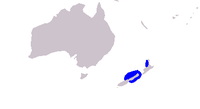Hector's Dolphin
|
|
| Hector's Dolphin Conservation status: Endangered | ||||||||||||||||
|---|---|---|---|---|---|---|---|---|---|---|---|---|---|---|---|---|
| Scientific classification | ||||||||||||||||
| ||||||||||||||||
| Binomial name | ||||||||||||||||
| Cephalorhynchus hectori | ||||||||||||||||
 Hector's Dolphin range |
Hector's Dolphin (Cephalorhynchus hectori) is the most well-known of the four dolphins in the genus Cephalorhynchus. At about 140cm in length, it is one of the smallest cetaceans.
Maui's Dolphin (Cephalorhynchus hectori maui) is a subspecies found off the northwest coast of the New Zealand's North Island. It is the most endangered subspecies of all marine mammals (other cetaceans with a similarly perilous conservation status inhabit rivers and estuaries only).
| Contents |
Physical description
The Dolphin has no discernible beak and a rounded fin. The fluke has pointed tips and concave trailing edges. The overall colour is a pale grey but closer inspection reveals a complex tapestry of colour. The forehead is grey with streaks of black. The tip of the beak is black. The throat and chest are white. Above that there is a dark grey patch running from the flippers (also dark grey) to the eyes. The belly is also white with a stripe running up the sides from under the dorsal fin. The bulk of the back and sides is the same lighter gray of the beak. The tail stock is narrow. At birth the animal weighs about 9kg and grows to about 40-60kg at adulthood. They live for about 20 years.
Hector's Dolphins live in fluid groups of about two to eight in number. They are active animals, readily bow-riding and playing with seaweed. When leaping from the sea, individuals will often land on their side, creating a loud splash (their vertical and horizontal dives are much less noisy).
Some sharks prey on Hector's Dolphins.
Population and distribution
Hector's Dolphins are endemic to the coastal regions of New Zealand. There are two known main populations, one on each side of the South Island. The two populations are believed to largely cut off from one another by deep water at Cook Strait and at the south-west tip of the South Island. The species seems unwilling or unable to cross areas of deep water. The total population was estimated to be around 3,500 in the mid-1980s. A more recent survey suggested a total population of only 2,000 to 2,500 individuals (see conservation below).
Hector's Dolphins are sighted always less than 10km off-shore in summer and only slightly further afield in winter. Occasional sightings were reported from Australia and Malaysia, but these were mis-identifications.
There are about 100 individuals in the Maui subspecies.
Conservation
The possiblility of entanglements in gillnets is a very significant threat to the Hector's Dolphin species. From 1970 such entanglements, which lead to certain death, are estimated to be responsible for the halving of the population. In 1988 a marine reserve was created around the Banks Peninsula to prevent gillnet activity in the area. This has stemmed the rate of population decrease, but an increase in numbers has not yet been recorded. Other threats, such as collisions with boat propellers and population may also be hampering a return to stability.
In March 2004, New Zealand's Department of Conservation began testing a system for satellite tracking cetaceans by tagging three Hector's Dolphins. If Hector's movements can be tracked successfully, the system will be extended to track the highly endangered Maui subspecies.
References
- National Audubon Society: Guide to Marine Mammals of the World ISBN 0375411410
- Encyclopedia of Marine Mammals ISBN 0125513402
- Whales, Dolphins and Porpoises, Mark Carwardine 1995 ISBN 0751327816
- BBC News report on satellite tracking technology (http://news.bbc.co.uk/1/hi/technology/3523337.stm)da:Hectors delfin
